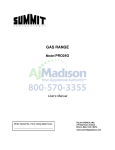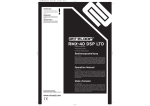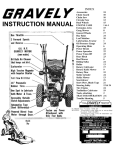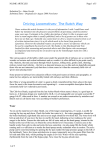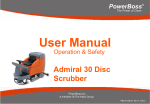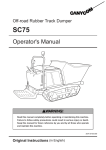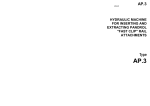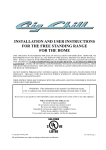Download Apex 49 User Manual
Transcript
Apex 49 Model: PB40GL,PB40PL,PB40GH,PB40PH User Manual Introduction Dear customer, It is our desire that the good characteristics of the Apex 49 should justify the confidence you demonstrated by making this purchase. Before first operation of the machine, Before first operation of your Apex 49, read these instructions and safety inread these instructions carefully. The formation carefully and comply with manual provides valuable information about operation, service and maintenance. them. Please be advised explicitly that we cannot accept any legal issues out of the contents of this manual. If repair work has to be performed make sure that only genuine spare parts are used; only genuine spare parts may guarantee a dependable machine. The symbol as used in this manual identifies items relevant to safety. Please observe the safety provisions (see chapter 1). Valid as of: 2 March 2007 Proper Use Proper Use The Apex sweeper has been exclusively designed for collecting dry and moist matter from floor surfaces in e.g. factories, storage buildings, parking ground and pedestrian areas. Using the machine beyond this scope of application will be deemed improper use; The manufacturer cannot be held liable for consequential damages. The term of proper use also includes operation, maintenance and repair work to be performed in compliance with the manufacturer's specifications. The Apex 49 may be used by personnel only that are familiar with the machine and aware of possible hazards involved. The applicable Accident Prevention Regulations, Road Traffic Regulations, and aspects of safety and working medicine in vigour will have to be complied with. If modifications to the machine are made in absence of the manufacturer's prior consent, the latter cannot be held liable for damage resulting from such unauthorized modification. The machine has not been designed for collecting dusts which are detrimental to health or explosive. parts or accessories without prior and explicit consent or by non-compliance with the maintenance instructions. Notes on warranty Inspection The terms of the sales contract apply. Damages are not subject to warranty if they are due to non-compliance with the maintenance and service provisions. The maintenance work has to be performed by an authorized service center and confirmed in the "Maintenance certificate" which is the warranty document. The following is excluded from warranty: fuses, natural wear, damages caused by overload, inexpert handling and unauthorised modification of the machine. Moreover, any claim for warranty cannot be accepted if damages at the machine are caused by fitting Carefully unpack and inspect your Apex 49 for shipping damage. Follow unpacking instructions on shipping pallet. Each unit has been tested and thoroughly inspected before shipment. Any damage is the responsibility of the delivery carrier who should be notified immediately. 3 Safety Information 1 1.1 Safety Information General Safety Information Apart from the instructions contained in this manual, the general safety instructions and accident prevention regulations, as imposed by law will have to be complied with. Do not put the Manual aside without reading it even if you used similar sweepers before. Take the time to read them now and save time later. Machines with known defects must not be used. It will be of essence to make yourself familiar with all accessories and controls and their functions before you start working. Avoid the mess of having to read this book while trying to run the machine. Using the machine in areas with explosion hazard, on public roads and places is prohibited. The operator has to use the machine within its design limits. Shut the motors down before transporting the machine. Keep clear of hazard zone! Before commencing work, the operator has to make sure that the SW5X and its accessories are in proper and safe condition. Warning and instruction labels attached to the machine contain important information about safe operation. Illegible or lost labels have to be replaced. Make sure that all covers are fitted before starting to sweep. Provide for sufficient ventilation when sweeping indoors (dust and combustion gas). Pinching and shearing hazard. Provide for required safe distance before lifting or lowering the dirt hopper. Shut down the engine before re-fuelling. Smoking and handling open flames is prohibited when filling fuel tanks or when working at or in the vicinity of components containing fuel. 5 Safety Information 1.2 Safety and Warning Symbols 1.2.1Generally Applicable Symbols All paragraphs in this manual referring to your personal safety, the safety of your machine and the environment protection are attributed one of the following warning symbols: Symbol Hazardous for.... Description DANGER persons and goods dangerous situation caused by misuse inaccurate adherence of instructions or prescribed work routine the machine important information on handling the machine in order to maintain operability the environment due to use of substances representing an inherent danger to health of environment CAUTION Ecological hazard 6 Safety Information 1.3 Labels at the Machine The following safety and information signs are legibly attached to the machine. Missing or illegible stickers have to be replaced. Inflation pressure (4) Ignition lock (6) 90 PSI Brake (7) Read and observe operator's Manual (5) Folding apron (1) Noise power level (8) 91 dB (A) Parking brake (2) Nameplate front (3) Fig.1 7 Safety Information 1.3 Labels at the Machine Hydraulic fluid (9) Cylinder broom wearing take-up (12) Rotating parts (10) Nameplate (13) Fig. 2 Safety and information signs 8 Burning surface (11) Safety Information 1.3 Labels at the Machine Pinching hazard (16) (Lifted-Up Disposal) High-pressure cleaner (14) Do not clean by means of high pressure cleaner or vapour jet. 9 Safety Information 1.4 Operation/Safety Information Vacuum sweepers may be run by qualified personnel only; such personnel will have to have evidenced their qualification for running the machine to the owner or his authorized representative; operators explicitly will have to be instructed by the owner or his authorized representative to use the machine. The machine may be used for cleaning such surfaces approved by the owner or this authorised representative for operation of vacu um sweepers. Before starting the engine, switch off all drives Transporting persons on the machine is prohibited. Ride-on machine types are to be started with the driver being seated. 10 Never leave the machine unattended before the motors are off and the machine is protected against unintended movements. To prevent the machine from unauthorized use, pull the control key to block all drives. Shut down the motors before transport of the machine. The driver has to take account of local conditions and when operating the sweeper he has to watch out for other persons, especially children. Do not open hood or fairings with the machine running. This machine must not be used as dust-evacuating machine with dust filter insert (separator) to collect dusts which are hazardous to health. Compared to four-wheeled vehicles, driving stability of three-wheeled vehicles is reduced. We thus recommend: - do not negotiate curves at high speed. - do not turn at slopes but on level ground only - ride up- or downhill straight. Safety Information Warning and instruction labels attached to the machine contain important information about safe operation Provide for sufficient ventilation when sweeping indoors (dust and combustion gas). Proceed to filter shaking only if the dirt hopper is in closed position. 1.5 Cleaning Information The machine is splash-proof (IPX3). Do not clean the SW5X by means of high pressure cleaner or vapour jet. Proceed to cleaning of the dirt hopper in regular intervals to preclude formation of bacterial deposits. 11 Safety Information 1.6 Maintenance Instructions A good approach to prevention of accidents is proper maintenance of the machine. Before proceeding to repair or maintenance work remove the key. Use appropriate tools for maintenance, service, setting etc. As far as aspects of safety are concerned, spare parts will have to be at least of the same quality as the genuine spare parts. Switch off the motors before maintaining the machine or replacing parts of it. Turn off the machine and pull the key. Check hydraulic hoses and lines for leakage or damages in regular intervals. Replace defective hoses and lines immediately. 12 Before changing wheels protect the machine against rolling by placing wedges. Proceed to wheel changing when the machine is on level and solid ground. Do not repair the pneumatic tires mounted to the machine yourself. Dismount the wheel and take it to repair to a tire workshop. Use of other than the cylinder brooms and side brushes approved by the manufacturer is not acceptable (see technical data) since use of other cylinder brooms and side brushes may affect your safety. When handling lubricating agents, the applicable regulations for protection of the environment and prevention of fire have to be complied with. Provide for disposal of used oil and grease in accordance with the provisions imposed by law. Collect cleaning agents, oil, fuel oil, grease etc. and provide for adequate disposal. Wipe away spilled substances. Safety Information Before commencing any work on the electric system disconnect battery (neg. lead) of the SW5X and pull the ignition key. Keep batteries dry and clean and clear of soiling such as e.g. metallic dust to avoid leakage current. Do not keep batteries dsicharged for a longer period; always recharge them as soon as possible. Do not place metal objects or tools onto batteries. Short-circuit and deflagration hazard. Top with distilled water only. Never refill battery acid in battery cells of perfect condition. Spilled (straight) battery acid must not get into the sewage system before having been neutralised. Comply with the regulations imposed by law and observe local provisions. Battery acid is highly caustic (keep clear of children). When checking the battery acid level, wear safety glasses. If acid splashes get into the eyes rinse with clear water for 15 minutes and contact a doctor immediately. Use appropriate protective means (e.g. protective gloves or finger-stalls) when handling battery acid. Do not use open flames (explosion hazard). 13 Description 2 Description 2.1 Functional Description The side brush is used to collect dirt at borders and to enlarge the working width as well as to increase the area performance on large surfaces. The cylinder broom casts the debris overhead into the dirt hopper. The collected fine dust is evacuated by the suction fan and separated by a filter system. The air returned into the environment is clean. Dirt disposal of the Apex 49 is via two dirt hoppers (2x30 litres) which are to be emptied manually. Dirt disposal of the Apex 49H (Lift-Up Disposal) is via lift-up disposal (lift-up height > 1350mm) directly into standard waste containers. Fig.3 14 Fig.4 Description 2.2 Cylinder Broom The cylinder broom is equipped with 12 rows of bristles arranged in V-shape. The cylinder broom width amounts to 27.6 in. (700mm) and its diameter to 13.6 in. (345mm). 2.3 Side Brush At the standard version, the side brush is located at the front right of the machine. The operator lifts and lowers it by hand lever. The side brush has a light inclination. The swinging area of the side brush arm is limited by stop screws. The side brush is driven by V-belt. For special application, fitting of a second side brush at the left is possible. 2.4 Filter System / Dust Evacuation The filter system is located in the filter case above the dirt hopper. The suction fan transports the fine dust raised by the cylinder broom to the plate filter where it is separated. The fine dusts sets at the outsides of the filter blades. In case of heavy dust development, check and clean the plate filter at regular intervals. 2.6 Steering Steering is controlled mechanically from steering wheel to front wheel via chain. This chain is to be re-adjusted as required. 2.7 Wheels Pneumatic tyres with hose, size. 4.00 - 4 6PR Inflation pressure: 90 PSI (6 bar) Solid rubber tyres (Option) 2.5 Shaking System Due to normal working vibration the set dust partly falls off into the dirt hoper. To ensure working in a dustfree environment, however, actuate the shaking system regularly, or after request by the pilot lamp at the latest. 15 Description 2.8 Brake The Apex 49 is equipped with a service brake. This brake has been constructed as shoe brake and equally serves as parking brake. It is located in the rear wheels and is actuated via cables. A special adjustment screw is situated at the right-hand rear wheel. Any work at the braking system has to be executed by qualified persons in a qualified workshop only. 2.9 Traction Drive Assembly The Apex 49 is equipped with a hydrostatic drive assembly which is driven by the combustion engine via pump. 16 2.10 Hydraulic System Lift-Up Disposal The hydraulic system comprises a compact unit (hydraulic pump with hydraulic tank), the hydraulic hoses and a hydraulic cylinder. Hydraulic fluid: Mobiloil DTE 15 M The named hydraulic fluid has been filled in the hydraulic system in the factory. Filling of hydraulic tank: 0.2 gal. (0.76 litre) First Operation 3 First Operation The Apex49 has been extensively tested and submitted to a functional check before delivery. Only qualified personnel of your local contract dealer are allowed to proceed to first operation. After shipping of the machine, we advise your contract dealer. He will contact you to make a date for briefing lessons. 3.1 General Smoking and handling open flames is prohibited when filling fuel tanks or when working at or in the vicinity of components containing fuel. Do not use the Apex 49 at ambient temperatures of more than 104°F (40°C). Do not start the machine at temperatures of 5°F (-15°C) or less. Liquid propellant gas system: refer to LPG operating instructions. Fuel tank 3.2 Refill Fuel The fuel tank is located under the foldable seat hood. Use clean fuel oil only. Store fuel in approved and closed reservoirs only. - Turn engine off - Secure machine by engaging the parking brake. - Pull ignition key. - Fold back seat hood. Fig.5 - Check filling level at the filling level indicator (Fig. 5/2). - Remove tank lid (Fig. 5/1) before filling. Turn engine off before filling fuel. Smoking and handling open flames is prohibited when filling fuel tanks or when working at or in the vicinity of components containing fuel. 17 First Operation 3.3 Check Engine Oil Level - Engine oil has been filled in the factory. - For safety reasons, check the engine oil level (refer to paragraph 6.9.2, Fig. 23/2) - In order to protect the engine, it is switched off or cannot be started if engine oil level is insufficient. This function is controlled by a low oil level switch (Fig. 0/1) at the engine. A red pilot lamp (Fig. 0/2) is situated at this switch and lights simultaneously in case of insufficient oil level. Engine Oil Level Before the machine is operable again, refill oil until the prescribed level is attained. Use clean oil only for refilling. Do not use used oil. 18 Fig.0 Store oil in approved and closed reservoirs only. Operation 4 Operation 4.1 Controls 1 2 3 4 5 6 7 8 Actuator for folding apron Service brake lock Service brake/parking brake pedal Drive pedal, reverse Drive pedal, forward Control panel Seat adjustment Safety knob, lock for release of swinging dirt hopper function (Lift-Up Disposal) 9 Release lever for swinging dirt hopper function (Lift-Up Disposal) Fig.6 19 Operation 1 Actuator for folding apron to open and close the folding apron for collecting coarse dirt. 2 Service brake/parking brake lock to lock the service brake/parking brake. If locked, the service brake works as parking brake. Release the lock by depressing the service brake pedal (3). 3 Service brake/parking brake pedal to actuate the service brake at the rear wheels. Before leaving the machine unattended, engage the service brake and lock. 4 Drive pedal, reverse to change direction to reverse ride with continuous regulation of riding speed at the same time. If the driver releases the pedal it returns to initial position and the machine slows down to standstill. 5 Drive pedal, forward to change direction to forward ride with continuous regulation of riding speed at the same time. If the driver releases the pedal it returns to initial position and the machine slows down to standstill. 6 Control panel Refer to chapter "Control panel" 7 Seat adjustment to adjust the seat position to drivers of different height. Adjust the seat so as to allow the driver being comfortably seated and attaining all elements required for operation. 20 - Adjust seat lengthwise: push lever slightly to the right and displace seat forwards or backwards to the required position. Then let the lever catch again. 8 Safety knob, lock for release of swinging dirt hopper function to release the lever for swinging dirt hopper function. 9 Release lever for swinging dirt hopper function to swing the dirt hopper Operation 4.2 Control Panel 1 Cylinder broom lever 2 Release of lifted-up disposal function 3 Horn 4 Suction fan/shaking system knob 5 Choke flap knob 6 Flashlight (option) 7 Lighting (option) 8 Lift and lower (Lift-Up Disposal) 9 Side brush lever 10 Pilot lamp, parking brake 11 Battery charge status indicator 12 Hourmeter 13 Pilot lamp, fan 14 Pilot lamp, shaking system 15 Engine speed regulation knob 16 Ignition switch Fig.7 21 Operation 1 Cylinder broom lever to lift and lower as well as to switch on and off the cylinder broom and the side brush. - Lower cylinder broom as well as switch on cylinder broom and side brush = push lever - Lift cylinder broom as well as switch off cylinder broom and side brush = pull lever 22 2 Release for lifted-up disposal function to release the lifted-up disposal function for lowering of lifting. Has to be actuated before pressing the key for lifting/lowering lifted-up disposal function. Hold the key during lifting/lowering. Before changing lifting to lowering or vice versa, the "Release Lifted-Up Disposal" key has to be released once and pressed again 3 Horn An acoustic signal sounds upon actuation of this button. Operation After jolting, the knob is to be kept in position 1 for about 10 seconds. Reduce engine speed to idling in order to optimize the cleaning result in case of heavy fine dust load. 4 Suction fan/shaking system knob Knob position (from bottom to top): Pos. 0 Activated vacuuming function (close flap before sweeping dry surfaces or collecting dry dirt). Pos. 1 Deactivated vacuuming function (open flap before sweeping wet surfaces and collecting wet dirt). Pos. 2 Shaking system ON (pull knob to stop and then release) If the yellow pilot lamp (Fig. 7/13) lights, actuate the shaking system (position 2). In this position, the shaking system is operable and proceeds to jolting in 7 repeated intervals. If the engine has already attained temperature, do not actuate the choke flap and start with full throttle. 6 Flashlight (option) to switch the flashlight ON/OFF. Do not hold the knob in position 2! 5 Choke flap knob to actuate the choke flap (cold start) - Knob down - choke not actuated - Knob pulled up - choke actuated for cold start. 7 Lighting (option) to switch the driving headlight ON/OFF. 23 Operation 8 Lift and lower (lifted-up disposal) to lift and lower the dirt hopper. Lift the dirt hopper by pressing the key until the desired height for lifting-out is attained. When lowering the dirt hopper make sure to hold the key pressed until the hopper has contact with the frame. 9 Side brush lever to lift and lower the side brush. - Lower side brush = push lever - Lift side brush = pull lever 12 Hourmeter indicates the operating hours. The counter works only if the driver is seated and the ignition is ON. Actuate release key for lifted-up disposal and hold before lifting or lowering. 10 Pilot lamp, parking brake (red) lights upon actuation of the parking brake Extinguishes upon release of the parking brake. 24 11 Battery charge status indicator (red) lights upon actuation of the ignition switch and has to extinguish as the engine fires. Operation 13 Pilot lamp, suction fan (orange) lights if the suction fan is not activated. 14 Pilot lamp, shaking system (yellow) Proceed to jolting of the filter system upon lighting of this pilot lamp by actuating the knob (Fig.7/5). 15 Engine speed regulation knob to adjust the engine speed. Service speed is attained by pulling the knob up. For safety reasons, the Apex has been equipped with a seat contact switch. Starting the engine is possible only after the driver has taken place on the seat. If seat contact is interrupted while the engine is running, the combustion engine of the Apex has to be re-started. 16 Ignition switch to switch ignition on and off, to start and stop engine and to secure it against unauthorised use. The pilot lamp flashes during the shaking procedure and extinguishes after filter has been cleaned. Jolting is effectuated in 7 intervals. 25 Operation 4.3 Empty Dirt Hopper - Fold bow (Fig. 8/3) up = the dirt hoppers (Fig. 8/2) are lowered. - Use the recessed grip (Fig. 8/1) of one of the hoppers to lift it lightly and extract it. - Take the hopper at its bow-type handle to disposal and empty. - Empty second dirt hopper as described above. - Re-insert dirt hopper (Fig. 8/2) and fold down the bow (Fig. 8/3). 1 Recessed grip in dirt hopper 2 Dirt hopper 3 Bow to lift/lower dirt hoppers Clean dirt hoppers at regular intervals. 4.4 Empty Dirt Hopper (Lift-Up Disposal) Lift side brush and cylinder broom before emptying of the dirt hoppers. Fig.9 If the hopper is lifted with the cylinder broom still running, the engine is switched off. 1 2 3 4 Lift-out arm Lift-out cylinder Dirt hopper Bow-type handle Fig.8 Clean dirt hopper at regular intervals. 26 Operation Riding with the lifted hopper reduces stability of the machine significantly. For this reason, do not lift the hopper but just before emptying. Before lifting the hopper, the operator has to make sure that no persons or objects are behind or next to the machine. Stop the machine on level ground before lifting the hopper. Pinching and shearing hazard. Provide for required safe distance before lifting or lowering the dirt hopper. Proceed to emptying of the dirt hopper as follows: - Control panel (Lift-Up Disposal) - When the hopper is lifted, the operator has to ride the machine slowly. - Keep clear of the hazard zone! Lift and switch off side brush and cylinder broom Proceed to shaking of the filter system Actuate switch (Fig. 10/1) and hold (dirt hopper is released) Actuate switch (Fig. 10/2) by pushing = lift dirt hopper Dirt hopper (Fig. 9/3) is lifted-out Back the SW5X until the dirt hopper is positioned above the container for disposal. Pull the safety knob (Fig. 11/1) of the release lever (Fig. 11/2). Release swinging of the dirt hopper by release lever (Fig. 11/2). Forward the SW5X after emptying. Fig.10 1 Release switch for lifted-up disposal function 2 Dirt hopper, lift and lower 27 Operation If the cylinder broom is switched on with the dirt hopper being lifted, the engine stops. - Lower dirt hopper by actuating switch (Fig. 10/1) and switch (Fig. 10/2); pull lever = lower dirt hopper Observe the information given in paragraph 4.2/2 on releasing of lifted-up disposal. If the hopper is lifted, the sweeping function is blokked. If the main broom is lowered even if the hopper is lifted, the combustion engine stops. Starting is then possible only after sweeping function is turned off (main broom lever in OFF position) or the hopper is lowered. (Under condition that the driver is seated) Lifted-up disposal function is blocked as long as sweeping function is ON. 28 Should the dirt hopper not be completely emptied after swinging, proceed to manual shaking with the handle (Fig. 9/4). Fig.11 Release lever, swing dirt hopper Clean the dirt hopper in regular intervals. 1 Safety knob 2 Release lever, swing dirt hopper The dirt hopper is approved only for a max. filling of 18.5 gal (70 litres) but not more than a weight of 242.5 lb (110 kg). Operation 4.5 Working with the machine The driver is requested to carefully read this manual. All controls are marked with easy-to-understand symbols that ease familiarization. First driving attempts should be limited to clear areas until you are familiar with all controls and their functions. Please comply with the following safety provisions: When working with the Apex all safety measures generally applicable for handling vehicles have to be observed. No passenger transport is admitted with the Apex 49. Warning and instruction labels attached to the machine contain important information about safe operation and guarantee your personal safety. Before commencing work, the operator has to make sure that the machine and its accessories are in proper and safe condition and comply with the provision for safety at work. Do not operate the Apex 49 without protective devices. 4.5.1 Before Start of Engine Open seat hood and check the following: - Engine oil level Visual check of the V-belts Fuel filling Open fuel cock (is located at a slot of the air cleaner) open - Close seat hood closed 4.5.2 Start Engine For safety reasons, the Apex 49 is equipped with a seat contact switch. Starting the engine is possible only when the driver is seated. - Switch all levers and switches to neutral position. Actuate parking brake. - Actuate choke (with cold engine only) - Turn ignition key to switch on ignition - Continue turning ignition key clokkwise to start engine. If the starting procedure has to be repeated or if the engine stops, re-starting is possible only after ignition has been turned off. The ignition lock is equipped with a protection to preclude repeated ignition with the engine running. 29 Operation Interruption of the starting procedure after 10 seconds and brief pause between starting cycles is recommended to save the battery. - Let the engine run and then slowly press the choke knob down. - Lower cylinder broom and side brush. - Release parking brake. - Slowly depress drive pedal until desired speed has been attained. - Regularly actuate shaking device to clean filter. - Check filling level of the dirt hopper and empty if required. Slowing down the Apex49 is possible by applying opposite forces with the drive pedal or by using the service brake. When leaving the machine unattended, pull key in order to preclude unauthorized use. 4.5.3 Stop Engine - Turn ignition key counter-clockwise. Refer to LPG operating instructions for information on how to start machine equipped with liquid propellant gas system. 4.5.4 Sweep - Start engine - Adjust service speed In initial position, vacuuming is activated. If the collected dirt is wet, open the flap. 30 4.5.5 Stop and Park - Release drive pedal which returns automatically into its neutral position and the machine slows down to standstill. - Actuate parking brake - Lift side brush and cylinder broom - Turn engine off Close the fuel cock in case of long-term standstill of the machine. Operation 4.5.6 Displace If the Apex should be moved with the engine being off, actuate the bypass valve (Fig. 12). Fig.13 Before displacement of the machine actuate the bypass valve located at the drive pump. To do so, turn the lever (Fig. 13/1) of the bypass valve anticlockwise approx. a quarter turn against the stop. Fig.12 Fig.13 4.5.7 Transport Before transporting the Apex 49 on other vehicles, engage the parking brake and secure the machine by straps and by placing wedges at the wheels. 31 Technical Data 5 Technical Data Apex 49 Dimensions and weights Length with side brush Width without side brush Width with 1 side brush Width with 2 side brushes Height above driver's seat Max weight including accessories Admissible total weight Driving and sweeping performance Forward speed Reverse speed Sweeping speed up to (4 km/h recommended) Sweeping track without side brushes - with 1 side brush - with 2 side brushes Theoretical sweeping perf. without side brushes - with 1 side brush - with 2 side brushes Gradability, max. 32 (Lift-Up Disp.) in. (mm) in. (mm) in. (mm) in. (mm) in. (mm) lb (kg) lb (kg) 59.8 (1520) 39.4 (1000) 44.1 (1120) 48.8 (1240) 51.2 (1300) 904 (410) 1278 (580) 59.8 (1520) 39.4 (1000) 44.1 (1120) 48.8 (1240) 51.2 (1300) 1058 (480) 1499 (680) mph (km/h) mph (km/h) mph (km/h) in. (mm) in. (mm) in. (mm) sq. ft./h (m² / h) sq. ft./h (m² / h) sq. ft./h (m² / h) % 3.7 (6,0) 2.5 (4,0) 3.7 (6,0) 27.6 (700) 28.2 (970) 48.8 (1240 45210(4200) 62430(5800) 80190(7450) 16 3.7 (6,0) 2.5 (4,0) 3.7 (6,0) 27.6 (700) 28.2 (970) 48.8 (1240 45210(4200) 62430(5800) 80190(7450) 16 Technical Data Apex 49 Filter system Filtering surface Plate filter Cylinder broom Length Diameter Wearing limit Speed Sweeping track Quantity of bristle rows Serial bristling Ground clearance of sealing strips at broom compartment Sealing strips - left - right - rear Sealing strip, front Side brushes Diameter Speed Serial bristling Dirt hopper Hopper capacity (Lift-Up Disp.) sq. ft. (m²) piece 30.1 (2,8) 1 30.1 (2,8) 1 in. (mm) in. (mm) in. (mm) rpm in. (mm) 27.6 (700) 13.6 (345) 11.4 (290) 530 +/- 20 2.0 + 0.4 (50+10) 12 v-shape PA 27.6 (700) 13.6 (345) 11.4 (290) 530 +/- 20 2.0 + 0.4 (50+10) 12 v-shape PA in. (mm) in. (mm) in. (mm) 0.04 (1) 0.04 (1) 0.16 (4) 0.04 (1) 0.04 (1) 0.16 (4) in. (mm) rpm 460 90 PA 460 90 PA gal (l) 2x7.9 (2x30) 18.5 (70) 33 Technical Data Apex 49 Drive wheels Pneumatic tyres with hose, size Inflation pressure Solid rubber tyres Engine Manufacturer Type Working process/no. of cylinders Piston capacity Performance at 3,600 rpm Service speed (with cylinder broom, side brush and suction fan being on) Fuel tank capacity (regular, unleaded) Fuel consumption Engine oil - filling Spark plug LPG-Spark plug, (Honda Part-No.) Air cleaner insert (Kawasaki) Pre-filter (Kawasaki) 34 PSI (bar) in.³ (cm³) KW rpm gal (l) gal/h (l/h) Typ gal (l) (Lift-Up Disp.) 4.00 - 4 6PR 90 (6) Option 4.00 - 4 6PR 90 (6) Option Kawasaki FE 250 D 4- stroke / 1 Zyl. 15.2 (249) 6 2475 +/- 25 Kawasaki FE 250 D 4- stroke / 1 Zyl. 15.2 (249) 6 2475 +/- 25 1.4 (5,3) 0.32 (1,2) 15W-40 0.3 (1,1) NGK BP 5 ES HON 98079-56846 11013-2128 11013-2129 1.4 (5,3) 0.32 (1,2) 15W-40 0.3 (1,1) NGK BP 5 ES HON 98079-56846 11013-2128 11013-2129 Technical Data Hydraulic system Travel drive assembly Hydraulic fluid, e.g. Mobiloil Hydraulic tank, capacity Fluid filter cartridge gal (l) Order-No Apex (Lift-Up Disp.) DTE 15 M DTE 15 M 2.6 (10) CS-050-P-10-A 2.6 (10) CS-050-P-10-A Hydraulic system Lifted-up disposal unit Compact unit (maintenance-free) Hydraulic fluid, e.g. Mobiloil DTE 15 M Hydraulic tank, capacity gal (l) Electric system Starter battery Generator V / Ah A 0.2 (0,76) 12 / 45 13 12 / 45 13 35 Technical Data Noise emission The sound pressure level measured according to DIN EN ISO 11201 and under standard operating conditions at the operator's ear with - operating status - fan, cylinder broom and side brush ON amounts to dB (A) 77 The sound power level measured according to DIN EN ISO 3744 under standard operating conditions and maximum volume flow amounts to dB (A) 91 Vibrations The frequency weighted acceleration measured according to EN 1003 which have an effect upon the upper limbs (hand-arm-system) amounts under normal working conditions ft./s2 (m/s2) < 8.07 (< 2,5) The frequency weighted acceleration measured according to EN 1032 which have an effect upon the lower limbs (feet and seat) amounts under normal working conditions ft./s2 (m/s2) < 1.64 (< 0,5) 36 Maintenance/Service 6 Maintenance/Service 6.1 Maintenance Instructions Compliance with our recommendations concerning maintenance work will give you the certitude of having an effective and dependable machine at your disposal. It is better to take precautions than repairing damages - and it saves money! The Apex has to be inspected for safe condition by an authorized expert as required, but not less than once a year. Results of such an inspection have to be kept on file at least until the next inspection is performed. Please contact your local distributor if you cannot do the maintenance works as prescribed in the maintenance schedule in-house. He will have these works done for you and has qualified personnel and genuine spare parts at disposal. When cleaning or servicing the machine, or replacing parts, have the motors stopped and the key removed, the negative battery pole disconnected and the service brake (parking brake) engaged. In case of questions or orders for spare parts, please always quote your machine's serial indicated on the nameplate Refer to chapter 1.3.1 Fig. 2/13 for position of nameplate. Collect spilled oil and provide for adequate disposal. Use appropriate tools for servicing, maintenance and adjusting work only. Spare parts at least will have to be of the same quality as genuine parts are. Do not remove or install tires or repair a rim. Take the wheel and rim to a workshop where qualified personnel and the required specific tools are available. When working at the electric system disconnect the negative pole of the battery. 37 Maintenance/Service 6.2 Mount/Dismount Cylinder Broom The cylinder broom is accessible from the left side of the machine and is to be dismounted as follows: - Open locks (Fig. 14/2) by enclosed square spanner (turn counter-clokkwise) - Remove cover (Fig. 14/1) - Lower cylinder broom - Pull ignition key and protect by engaging parking brake - Remove cover - Turn handle (Fig. 15/3 +5) upwards and unlock - Remove plate with sealing strip (Fig. 15/4) - Remove cylinder broom by pulling. For mounting the cylinder broom proceed in inverse order. 6.3 Adjust Sweeping Track An adjustment device allows adaptation to different sweeping conditions. The cylinder broom has to be adjusted for normal use and with regard to a low degree of wearing as described in the following. Check the broom adjustment on level ground as follows. Fig.15 Dismount cylinder broom Remove cover 38 Fig.14 - Loosen star-shaped knob (Fig. 15/2) and remove - Remove cylinder broom seating (Fig. 15/1) Maintenance/Service With one full turn of the knob, the track widens or broadens by approx. 0.4 in. (10mm). Before checking: Mark level surface for checking broom adjustment by chalk. Check inflation pressure of tyres 90 PSI (6bar). - Secure machine by engaging parking brake. - Lower cylinder broom and let it run dry. - Lift cylinder broom and forward the Apex 49 a bit. With the correct broom adjustment the parallel sweeping marks have to appear on the floor (sweeping track). The sweeping track width of th Apex is to be 1.97 in. (50mm) The sweeping track width can be adjusted at the star-shaped knob (Fig. 16/2) as follows: When exceeding the sweeping track width the cylinder broom wearing increases as well as the load of the drive. Fig.16 Broom adjustment - Stop engine and pull key Engage parking brake Open seat hood Loosen handle (Fig. 16/3) Turn star-shaped knob (Fig. 16/1) to the left = wider sweeping track to the right = smaller sweeping track - Fix handle (Fig. 16/3) - Broom adjustment sticker (Fig. 16/2) Fig.17 Fig. 17 Broom adjustment sticker (in Fig. 16/2) 39 Maintenance/Service 6.4 Sealing Strips for Broom Compartment In order to assure good function of the sweeper, a perfect condition of the sealing strips is required, especially in order to attain the prescribed low pressure in the broom compartment, a clean sweeping result and the less possible wear of the sealing strips (check the sealing strips of the broom compartment for wearing and damages in regular intervals). Replace defective sealing strips. The ground clearance of the lateral and rear sealing strips is adjustable (oblong holes in the sealing strips). Ground clearance sides: approx. 0.04 in. (1mm) rear: approx. 0.16 in. (4mm) Proceed to adjustment with an inflation pressure of the pneumatic tyres of 90 PSI (6bar). Height of the front sealing strip (folding apron) cannot be adjusted. Being dragged, it has contact with the floor. 40 6.5 Folding Apron Adjustment Adjust folding apron - Remove bolt (Fig. 18/2). - Modify adjustment by turning the fork head (Fig. 18/1). Modify adjustment such that the cylinder broom does not retract the sealing strip of the folding apron during operation. Fig.18 - Turn engine off and pull key - Secure machine by engaging parking brake - Remove cover (as described in the paragraph "Mount/Dismount Cylinder Broom"). Maintenance/Service Proceed in inverse order for mounting of the side brush. 6.6 Replace Side Brush The side brush is located at the front right of the machine (standard version). Use the lever (paragraph 4.2, Fig. 7/9) to lift and lower the side brush. The side brush is to be lightly inclined in forward and in outward direction. The swinging area of the side brush arm is limited by stop screws. The side brush is driven by a V-belt. Fitting of a second side brush for specific appliances is possible. Proceed as follows for dismounting of the side brush: Replace side brush Fig.19 - Turn engine off and pull key. - Secure machine by engaging parking brake - Disconnect battery plug - Side brush lifted - Loosen hexagonal nut (Fig. 19/1) und remove together with washer - Remove screw (Fig. 19/2) - Remove side brush 41 Maintenance/Service 6.7 Dismount Plate Filter Proceed as follows for dismounting of the plate filter: - Turn engine off and pull key. - Secure machine by engaging parking brake - Open seat hood - Open quick-release locks (Fig. 20/1) - Remove cover, filter case (Fig. 20/2) - Loosen wing screws (Fig. 21/2) and remove. - Fold back frame with electric-motor (Fig. 21/3). - Hook frame at indicated position (Fig. 21/4) - Remove plate filter (Fig. 21/5). For mounting of plate filter proceed in inverse order. 42 Fig.20 Dismount plate filter 1 Quick-release locks 2 Cover of filter case 3 Filter case Maintenance/Service Fig.21 Plate filter 1 2 3 4 5 Detent hook Wing screws Frame with electric-motor Opening for detent lever Plate filter 43 Maintenance/Service 6.8 Basic Cleaning of Plate Filter Hold the plate filter (Fig. 22/1) in vertical position and drop it from a height of approx. 3 ft. (1 m) to the even floor as represented in Fig. 22. The soiled side of the filter points to the bottom. Soiled side Clearance approx. 3ft. (1 m) Floor Fig.22 Basic cleaning of plate filter 1 Plate filter 44 Maintenance/Service 6.9 Engine The engine is a robust four-stroke engine and easy-to-maintain. Maintenance work is to execute at regular intervals. Find the details described in the following. 6.9.1 Check Engine Oil Level Position the machine on level ground before checking the engine oil level as follows: Before cleaning or maintaining the machine as well as before replacing parts, turn the engine off and pull the ignition key. Use appropriate tools for maintenance, service, setting etc. As far as aspects of safety are concerned, spare parts will have to be at least of the same quality as the genuine spare parts. - Turn engine off and pull key. - Secure machine by engaging parking brake - Open seat hood - Pull plug (Fig. 23/1) with dipstick. - Wipe dipstick, push it into opening until stop and pull it again. - Oil level has to mark between minimum and maximum, refill engine oil if required. - Re-insert plug. The engine stops automatically in case of insufficient oil level to preclude damages. Fig. 23 Engine oil level check If the machine has not been used for a longer time, let the engine run to have the oil attained appropriate temperature. 45 Maintenance/Service 6.9.2 Change Engine Oil Proceed to the following befor changing engine oil: Direction of travel Fig.24 Engine oil changing, right side of machine Caution! Burning hazard at muffler pipe! If the machine has not been used for a longer time, let the engine run to have the oil attained appropriate temperature. 46 - Turn engine off and pull key. - Secure machine by engaging parking brake. - Open seat hood. - Loosen quick-release locks (Fig. 20/1). - Remove cover, filter case (Fig. 20/2). - Loosen screws at the inside of the right lateral fairing and remove. - Lightly tilt lateral fairing to the outside then remove by pulling up. - Remove drain hose (Fig. 24/1) from holding clamp (Fig. 24/2) and lead it downwards through the vehicle frame. - Loosen clamp, pull drain plug from the hose and drain oil. - Close drain hose (Fig. 24/1) by plug and protect with clamp. - Fasten drain hose (Fig. 24/1) at holding clamp. - Fill engine oil into check opening with the machine standing on level ground. - Check oil level with dipstick, continue filling if required Engine oil: SAE 15 W-40 Filling: approx. 0.3 gal (1.1 litre) Use an oil-resistant funnel for filling engine oil. 6.9.3 Air Cleaner The air cleaner is located in the engine's compartment. Clean the foamtype filter after every 50 hours of operation and the paper insert after every 100 hours of operation. Proceed to daily cleaning of the air cleaner with heavy dust formation. Maintenance/Service Replace filtering insert as required. Proceed as follows for dismounting the filtering insert: - Unscrew wing screw (Fig. 25/2) and remove filter cap (Fig. 25/3) with filtering insert. - Remove foam-type filter and paper filter (Fig. 26/3 and 4) and proceed to dry cleaning or replace if required. 6.10 Hydraulic System The hydraulic units are maintenancefree. The hydraulic oil and filters are concerned by maintenance work only. Premature failure can be prevented by regular inspection and periodical maintenance (see maintenance schedule). We recommend having all other works at the hydraulic system done by qualified personal. Air cleaner Fig.25 1 Air cleaner 2 Wing screw 3 Air cleaner cap with filtering insert Fig. 26 A soiled filtering insert may lead to reduced performance and heavy smoking of the engine. Never let the engine run without filtering insert. Air cleaner components 1 2 3 4 Wing screw Air cleaner cap Foam-type filter Paper filter 47 Maintenance/Service 6.10.1 Check Hydraulic Fluid Level 6.10.3 Change Hydraulic Fluid Filter - Turn engine off and pull key. - Secure machine by engaging parking brake. - Open seat hood. - Unscrew cap with dipstick (Fig. 27/1) - Wipe dipstick by means of cloth - Screw cap until stop - Unscrew cap with dipstick and check hydraulic fluid level, refill if required The hydraulic fluid filter is located in the pump line and equipped with a bypass valve in order to guarantee fluid supply of the travel drive assembly even if the fluid filter is soiled. Change the fluid filter after the first 100 hours of operation. 6.10.2 Refill Hydraulic Fluid - - Unscrew cap with dipstick and check hydraulic fluid level according to paragraph 6.10.1. - Use appropriate oil-resistant recipient with mouth or funnel for refilling - Proceed to check of fluid level after refilling - - Hydraulic fluid filter Fig.27 1 Filler neck 2 Hydraulic oil filter - Filling is sufficient if the bottom end of the dipstick immerges into the fluid for approx. 0.2 in. (5mm). 48 Turn hydraulic fluid filter (Fig. 27/2) counter-clockwise to loosen it and unscrew Before screwing new filter, fill it with oil Ride the machine a short distance Refill sufficient hydraulic fluid Check fluid filling level Hydraulic fluid: Mobil DTE 15 M or a fluid of similar quality. Maintenance/Service Should it be required to drain the hydraulic fluid completely proceed as follows: 6.10.4 Check and Refill Hydraulic . . System (Lift-Up Disposal) - Turn engine off and pull key. - Secure machine by engaging parking brake. - Remove right-hand dirt hopper or lift the dirt hopper (see paragraph 4.3/4.4). - Place recipient under the drain plug (drain plug is located underneath the filter case at the right) and remove drain plug. - Check hydraulic fluid level in tank (Fig. 28/1). The hydraulic fluid level must not fall below the minimum (Fig. 28/2). It should read between the minimum (Fig. 28/2) and the maximum (Fig. 28/3). Refill hydraulic fluid - Remove lid (Fig. 28/4) and refill as required. - Close lid of hydraulic fluid tank. Use Mobiloil DTE 15 M fluid or a hydraulic fluid of similar quality. Fig.28 Dirt hopper has to be lowered. Hydraulic unit lifted-up disposal Check hydraulic fluid level - Turn engine off and pull key. - Secure machine by engaging parking brake. - Open seat hood 49 Maintenance/Service 6.11 V-Belt Drive 1 2 3 4 5 6 7 8 9 10 11 12 13 14 15 16 17 18 19 Suction fan V-belt (40Hz) Tensioning roller V-belt pulley Hydraulic pump V-belt Belt guide Hexagonal nut V-belt for cylinder broom and side brush drive Hydraulic pump belt pulley Tensioning / coupling roller Screws Side brush V-belt Belt pulley Cylinder broom V-belt Cylinder broom belt pulley Tension spring Tensioning roller lever Tension spring Tensioning roller lever for hydraulic pump V-belt Tensioning roller lever for cylinder broom and side brush drive V-belt drive 50 Fig.29 Maintenance/Service 6.11.1 Replace Cylinder Broom V-Belt 6.11.2 Replace Side Brush V-Belt 6.11.3 Replace Suction Fan V-Belt - Turn engine off and pull key. - Secure machine by engaging parking brake. - Remove bottom right fairing (turn locks counter-clockwise by square spanner). - Detent tensioning spring (Fig. 29/15) by left hand while taking the V-belt off the tensioning roller with right hand. - Remove V-belt (Fig. 29/13). - Turn engine off and pull key. - Secure machine by engaging parking brake - Remove bottom right cover (turn locks counter-clockwise by square spanner). - Remove cylinder broom V-belt (as described in paragraph "Replace Cylinder Broom V-Belt") - Loosen screws (Fig. 29/10) at the cover plate and remove - Remove cover plate - Push side brush from the front side in direction of the machine to detent V-belt (Fig. 29/11) - Remove V-belt (Fig. 29/11) - Turn engine off and pull key. - Secure machine by engaging parking brake - Open seat hood - Loosen hexagon nuts (Fig. 29/6) and remove together with belt guide (Fig. 29/5) - Detent V-belt (Fig. 29/7) with tensioning roller lever (Fig. 29/19) and take from the belt pulley - Loosen tensioning roller (Fig. 29/2) and detent the V-belt, and then remove. Proceed in inverse order for mounting. Proceed in inverse order for mounting. Proceed in inverse order for mounting. 51 Maintenance/Service 6.11.4 Replace Hydraulic Pump VBelt - Turn engine off and pull key. - Secure machine by engaging parking brake - Open seat hood - Loosen hexagon nuts (Fig. 29/6) and remove together with belt guide (Fig. 29/5) - Detent V-belt (Fig. 29/7) with tensioning roller lever (Fig. 29/19) and take from the belt pulley - Loosen tensioning roller (Fig. 29/2) and detent the V-belt, and then remove. - Unhinge tension spring (Fig. 29/17). - Remove V-belt (Fig. 29/4). Proceed in inverse order for mounting. 52 Maintenance/Service 6.12 Electric System 1 F2 Pre-fuse (20A) 2 F3 Engine shutdown, hourmeter (5A) 3 F4 Indicators control panel, jolter controlling, (front right lighting option, right rear light (5A) 4 F5 Horn (10A) 5 F7 LPG equipment option (10A) 6 F8 Front left lighting option, left rear light (7.5A) 7 F9 Lifted-up disposal control (7.5A) 8 F10 LPG equipment option (10A) 9 F11 Shaking motor (30A) 10 F12 Generator charge status indicator (5A) 11 F14 Flashlight option (5A) 12 LPG option control unit 13 K6 Relay, (Lift-Up disposal) 14 K7 Relay, (Lift-Up disposal) 15 K8 Relay, (Lift-Up disposal) 16 K9 Relay, (Lift-Up disposal) 17 K10 Relay, (Lift-Up disposal) 18 K11 Relay, lower hopper 19 K3 Relay 20 K4 Relay, filter monitoring 21 K5 Relay, impulse relay shaking 22 F13 Hydraulik unit for (Lift-Up disposal) 30A Fig. 30 53 Maintenance/Service 6.13 Maintenance Schedule hours of operation Daily after first every 100 every 200 every 500 alle 000 Check engine oil level and refill if required X Check fuel level and refill if required (regular unleaded) X Replace fuel filter (as required) X Change engine oil (1.1 litre engine oil SAE 15-W-40) Check engine air cleaner for soiling and clean if required (tap, do not use compressed air), replace air cleaner insert if required 5 X X X Visual check of engine, pump and wheel motor for oil leakage X Check idling and service speed (1,200rpm and 2475rpm) X Check spark plug air gap 0.03 in. (0.75mm) LPG: 0.01 in. (0.3mm) X Replace spark plugs X Check valve play 0.006 in. (0.15mm inlet, 0.15mm outlet) each in cold state X Check starter battery acid level and top with distilled water if required, clean and grease battery terminals Change hydraulic fluid filter and refill fluid (use Mobiloil DTE 15 M or fluid of equivalent quality) Check cables and plugged connections for damages and tight fit 54 X 100 X X Maintenance/Service 6.13 Maintenance Schedule hours of operation Daily after first every 100 every 200 every 500 alle 000 Check function of seat contact switch X Check exhaust system X Check inflation pressure 90 PSI (6bar) X Check cylinder broom for wearing or foreign particles (e.g. wire, straps) and replace broom if required X Check sweeping track and adjust if required X Check sealing strips at the broom compartment, adjust if required or replace defective sealing strips X Check sealing strips at dirt hopper, replace defective sealing strips X Check side brush adjustment and brush bristles for wearing, adjust if required or replace side brush Visual check of V-belts Check V-belt for wearing and correct tension and re-adjust if required X X 5 X Check service/parking brake and re-adjust if required X Check filter system for tightness X Dismount plate filter and clean if required X Check tread of wheels X 55 Maintenance/Service 6.13 Maintenance Schedule hours of operation Daily after first every 100 every 200 every 500 alle 000 Check hydraulic fluid level of lifted-up disposal function and refill if required Check tightening moment of fixing screws for lifted-up disposal and tighten if required 36 lb. ft. (49Nm) X 5 X Check hydraulic hoses and replace if required X Check tension of steering chain and adjust tension if required X 56 Liquid Propellant Gas System USER TIPS - Allow only qualified and trained personnel to operate a Minuteman Propane sweeper. - Always check fuel system for leaks with soapy water. (Hoses, regulators, connections) - Always maintain your Minuteman Propane sweeper, follow operating and maintenance instructions. - Never smoke while operating or working on sweeper. - Always check oil level before starting. - Keep hands, feet, hair, clothing, etc. away from brushes, pulleys, and any other moving parts on equipment. - Always keep accurate records of maintenance and service in a maintenance log book. - Never overfill a propane fuel tank. Be sure to follow safety instructions for venting overfilled tanks in safety section in this manual. - Never leave machine unattended with engine running. - Never change or alter fuel system unless authorized by Minuteman International Inc. Service Department. - Always keep nuts and bolts tightened and hose connection snug. - Always store propane tank outside in an approved, secured, and tamper proof enclosure to provide safety from vandalism and accidents. - Never use a non-sweeper listed fuel tank on your propane buffer. - Always operate your sweeper, with exhaust (muffler) pointed away from merchandise, furniture, etc. Heat from exhaust may cause damage. - For all engine repairs refer to the engine manual included with this parts and instruction book. - If you smell gas, do not touch any electric switch, extinguish any open flame and contact your gas supplier, and open windows. CAUTION Visible escaping gas vapor is extremely cold (ICE). Degrees (-44) avoid contact. CAUTION Propane gas is heavier than air. The gas will settle to the lowest possible area and build upwards. - If there is any smell of propane fuel, check immediately for leaks. - Do not store any other flammable liquids or vapors in the vicinity of propane storage area, machine storage area or any other appliance. - Do not place flammable objects such as matches, fuel, etc., close to the engine while it is running. CAUTION Build-up of propane vapor in any enclosed area, can cause an explosion if ignited. Operate only in wellventilated areas. - When parking the machine, immediately close the tapping valve of the cylinders. - Never attempt to repair a propane fuel tank by yourself. Tanks can only be repaired by a Department of Transportation authorized facility. - Check liquid propellant gas systems for proper condition, function and leakage at regular intervals. - For repairs or adjustments on your Propane sweeper use only an authorized Minuteman Service Center. - Engine will not start if rego coupling is crossed, (fuel line connection) make sure fuel line connection is properly done. 57 Liquid Propellant Gas System SAFETY PRECAUTIONS Before operating the engine, read the Operator’s Manual and become familiar with it and the equipment. Safe and efficient operation can be achieved only if the equipment is properly operated and maintained. The following symbols, found throughout this manual, alert you to potentially dangerous conditions to the operator, service personnel, or the equipment. DANGER This symbol warns of immediate hazards that will result in severe personal injury or death. WARNING This symbol refers to a hazard or unsafe practice that can result in severe personal injury or death. CAUTION This symbol refers to a hazard or unsafe practice that can result in personal injury or product or property damage. Fuels, electrical equipment, batteries, exhaust gases and moving parts present potential hazards that can result in severe personal injury. Take care in following these recommended procedures. All local, state and federal codes should be consulted and complied with. GENERAL - Provide appropriate fire extinguishers and install in convenient locations. Use an extinguisher rated ABC by NFPA. - Make sure that all fasteners on the engine are secure and accurately torqued. Keep guards in position over fans, driving belts, etc. 58 - If it is necessary to make adjustments while the engine is running, use extreme caution when close to hot exhausts, moving parts, etc. - Used engine oils have been identified by some state or federal agencies as causing cancer or reproductive toxicity. When checking or changing engine oil, take care not to ingest, breathe the fumes, or contact used oil. - Do not work on this equipment when mentally or physically fatigued, or after consuming any alcohol or drug that makes the operation of equipment unsafe. BATTERIES - Before starting work on the engine, disconnect batteries to prevent inadvertent starting of the engine. - DO NOT SMOKE while servicing batteries. Lead acid batteries give off a highly explosive hydrogen gas which can be ignited by flame, electrical arcing or by smoking. - Verify battery polarity before connecting battery cables. Connect negative cable last. FUEL SYSTEM - DO NOT fill fuel tanks while engine is running. - DO NOT smoke or use an open flame in the vicinity of the engine or fuel tank. Internal combustion engine fuels are highly flammable. - Fuel line must be LP approved, adequately secured, and free from leaks. Piping at the engine should be approved flexible line. Do not use copper piping for flexible lines as copper will work harder and become brittle enough to break. - Be sure all fuel supplies have a positive shut-off valve. PROTECT AGAINST MOVING PARTS - Do not wear loose clothing in the vicinity of moving parts, such as PTO shafts, flywheels, blowers, couplings, fans belts, etc. - Keep your hands away from moving parts. EXHAUST SYSTEM - Exhaust products of any internal combustion engine are toxic and can cause injury, or death if inhaled. When operating the engine in a confined area, make sure the ventilation system is operating properly. - DO NOT use exhaust gases to heat a compartment. - Make sure that your exhaust system is free of leaks. Make sure that exhaust manifolds are secure and are not warped by bolts unevenly torqued. EXHAUST GAS IS DEADLY! - Exhaust gases contain carbon monoxide, a poisonous gas that can cause unconsciousness and death. It is an odorless and colorless gas formed during combustion of hydrocarbon fuels. Symptoms of carbon monoxide poisoning are: Dizziness, Headache, Weakness and Sleepiness, Throbbing in Temples, Vomiting, Muscular Twitching If you experience any of these symptoms, get out into fresh air immediately, shut down the unit and do not use it until it has been inspected. The best protection against carbon monoxide inhalation is proper installation and regular, frequent inspections of the complete exhaust system. If you notice a change in the sound or appearance of exhaust system, shut the unit down immediately and have it inspected and repaired at once by a competent mechanic. KEEP THE UNIT AND SURROUNDING AREA CLEAN - Make sure that oily rags are not left on or near the engine. - Remove all unnecessary grease and oil from the unit. Accumulated grease and oil can cause overheating and subsequent engine damage and present a potential fire hazard. Liquid Propellant Gas System SAFETY INFORMATION For Your Safety! These safety precautions should be followed at all times. Failure to follow these safety precautions could result in injury to yourself and others. Accidental Starts! Before servicing the engine or equipment, always disconnect the spark plug lead to prevent the engine from starting accidently. Ground the lead to prevent sparks that could cause fires. On engines equipped with a 12-volt battery and/or electric start, disconnect the battery cables from the battery. Always disconnect the negative (-) cable first. Before disconnecting the negative (-) ground cable, make sure all switches are OFF. If ON, a spark will occur at the ground cable terminal which could cause an explosion if hydrogen gas or fuel vapors are present. Explosive Fuel LPG is extremely flammable and is heavier than air and tends to settle in low areas where a spark or flame could ignite the gas. Do not start or operate this engine in a poorly ventilated area where leaking gas could accumulate and endanger the safety of persons in the area. To insure personal safety, installation and repair of LPG fuel supply systems must be performed only by qualified LPG system technicians. Improperly installed and maintained LPG equipment could cause fuel supply system or other components to malfunction, causing gas leaks. Observe federal, state and local laws governing LPG fuel and systems. Dangerous Acid, Explosive Gases! Batteries contain sulfuric acid. To prevent acid burns, avoid contact with skin, eyes and clothing. Batteries produce explosive hydrogen gas while being charged. To prevent a fire or explosion, charge batteries only in well ventilated areas. Keep sparks, open flames, and other sources of ignition away from the battery at all times. Keep batteries out of the reach of children. Remove all jewelry when servicing batteries. Before disconnecting the negative (-) ground cable, make sure all switches are OFF. If ON, a spark will occur at the ground cable terminal which could cause an explosion if hydrogen gas or gasoline vapors are present. WARNING CAUTION Over-speed is Hazardous! High Voltage! Never tamper with the govenor components or settings to increase the maximum speed. Severe personal injury and damage to the engine or equipment can result if operated at speed above maximum ratings. Never touch electrical wires or components while the engine is running. They can be sources of electrical shock which could cause severe injury or burns. 59 Liquid Propellant Gas System SAFETY INFORMATION Lethal Exhaust Gases! Engine exhaust gases contain poisonous carbon monoxide. Carbon monoxide is odorless, colorless, and can cause death if inhaled. Avoid inhaling exhaust fumes, and never run the engine in a closed building or confined area. Rotating Parts! Keep hands, feet, hair, and clothing away from all moving parts to prevent injury. Never operate the engine with covers, shrouds, or guards removed. The crankcase, cylinder head, exhaust system, and other components can get extremely hot from operation. To prevent severe burns, do not touch these areas while the engine is running - or immediately after it is turned off. Never operate the engine with heat shields or guards removed. PROPANE TANK The tank supplied with this equipment is a horizontal vapor withdrawal 20 lb. tank. Do not overfill. Fill tank to 80% of rated capacity. Safety fill, Aluminum unpolished, polished, and steel. All propane tanks are equipped with this special warning sticker. Please read. WARNING: Vapor withdrawal tank weight fill only! Failure to weight fill tank will void warranty and cause damage to propane components! Tare weight is stamped on the tank. DANGER: Liquid propane is highly flammable and its vapors are explosive. To prevent personal injury or property damage: - Do not allow open flame, matches, or smoking in area. - Never overfill a propane tank. The tank supplied with this machine is a horizontal vapor withdrawal 20 lb. tank. Weight fill tank only 80% of rated capacity. Tare wieght is stamped on the tank. - Always store propane tank outside in an approved, secured, tamper proof enclosure to provide safety form vandalism and accidents. - Never usa a non-UL listed propane tank. 60 Liquid Propellant Gas System FIRST OPERATION Operation Refer to the Sweeper operating instructions for information on operation; the present manual contains specifications for liquid propellant gas system only. Start engine - Set all operating elements and switches to neutral position. NOTE Do not contact the drive pedal by foot. - Actuate parking brake. - Open cylinder valve. - Set speed governor to full throttle position - Pull choke knob as well if engine has already attained service temperature. - Turn ignition start switch to position 1. - Continue turning ignition start switch to position 2 until the engine cranks. Push choke flap knob back at the first ignition impulses already. Then release ignition start switch. NOTE Should the engine not start after 5 seconds, interrupt starting procedure, turn ignition start switch to "0" position and repeat starting procedure. The starting procedure may be extended to 15 seconds at temperatures below 32°F (0°C). NOTE Let engine run for some seconds before pushing back the choke knob. CO contents of the exhaust gas The CO contents of the exhaust gas must not exceed 0.1 % by volume when idling (1,400 to 1,450 rpm) and if engine is at operating temperatures without use of working implements. Qualified persons and workshops with personnel having evidenced qualification for execution of such works is authorized only to proceed to setting work. Stop engine - Actuate parking brake - Set engine speed governor to idling position - Turn ignition off - Close cylinder valve. Before a longer out-of-operation period of the machine (longer than one hour), switch off ignition only if engine has died away itself after closing of the cylinder valve. 61




























































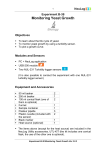


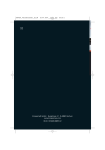
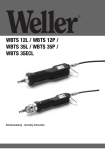
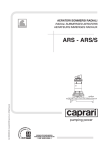
![Maximum Model service Manual.ppt [호환 모드]](http://vs1.manualzilla.com/store/data/006002079_1-f9e925e4876feffe85b493d91263fd66-150x150.png)


